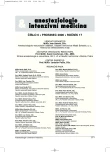Physostigmine and its place in modern anaesthesiology and intensive care
Authors:
L. Hess 1; J. Málek 2; J. Schreiberová 3
Authors‘ workplace:
Centrum experimentální medicíny, IKEM Praha
1; Klinika anesteziologie a resuscitace 3. LF UK a FNKV, Praha
Klinika anesteziologie, resuscitace a intenzivní medicíny, FN Hradec Králové
2
Published in:
Anest. intenziv. Med., 17, 2006, č. 6, s. 287-294
Category:
Anaesthesiology - Comprehensive Report
Overview
Physostigmine was isolated from Calabar (ordeal) beans in 1864 and used for glaucoma therapy. Nowadays its main indication is the treatment of the central anticholinergic syndrome which is a relatively common complication of general anaesthesia and analgesic sedation in the ICU. The pharmacokinetic and pharmacodynamic properties and interactions of physostigmine with drugs commonly used in anaesthesia (volatile anaesthetics, propofol, benzodiazepines, opioides and dehydrobenzperidole) are described. A short review of the central anticholinergic syndrome symptoms and therapy is presented. Physostigmine effects on ethyl alcohol intoxication, muscle shivering and Alzheimer’s disease are also mentioned.
Key words:
physostigmine – history – pharmacology – central anticholinergic syndrome
Labels
Anaesthesiology, Resuscitation and Inten Intensive Care MedicineArticle was published in
Anaesthesiology and Intensive Care Medicine

2006 Issue 6
Most read in this issue
- Physostigmine and its place in modern anaesthesiology and intensive care
- Flumazenil – a specific antagonist of the benzodiazepines at the beginning of the 21st century. Is it needed?
- Measurement of cardiac output by the pulse contour analysis (LiDCOTM plus) and the partial rebreathing of carbon dioxide (NICO) methods – a prospective comparative study
- TOF-Watch® SX vs. Datex-Ohmeda M-NMT: A comparison of the TOF-ratio measured with accelerometry or electromyography. A clinical, prospective, controlled study.
